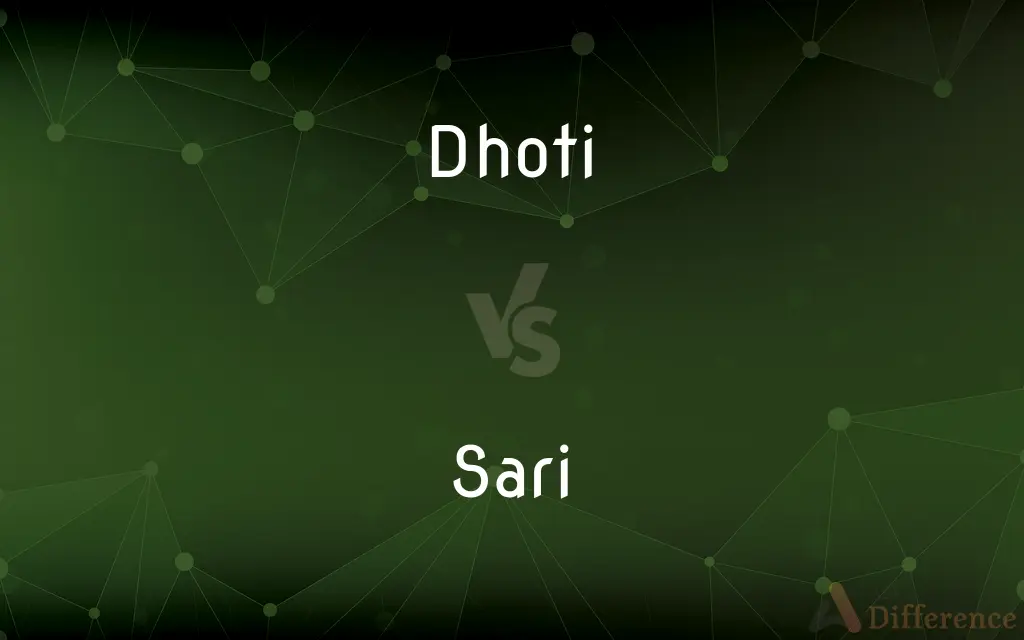Dhoti vs. Sari — What's the Difference?
By Fiza Rafique & Maham Liaqat — Updated on April 27, 2024
A dhoti is a traditional men's garment worn in India, typically wrapped around the waist and legs, whereas a sari is a long strip of cloth draped around the body, worn by women.

Difference Between Dhoti and Sari
Table of Contents
ADVERTISEMENT
Key Differences
Dhotis are made from a piece of rectangular cloth, usually cotton or silk, wrapped around the waist and legs and knotted at the waist. Whereas saris are much longer, usually five to nine yards in length, and are wrapped around the waist, with one end draped over the shoulder.
Traditionally, dhotis serve as both casual and formal attire for men in various parts of India, adapted for daily wear or special occasions like weddings. On the other hand, saris are primarily worn by women and are versatile enough to be styled for everyday use or luxurious gatherings.
A dhoti typically requires skill in tying and maintaining its hold, as it involves precise folds and tucks around the waist and legs. In contrast, draping a sari also requires technique but varies widely in style across different Indian cultures, influencing how it is worn and the appearance it presents.
Color and fabric choices in dhotis are generally more subdued and less varied than those in saris, which can range from simple cotton to intricate silk with detailed embroidery and decorations. Saris often feature vibrant colors, elaborate patterns, and a wide range of textures.
While the dhoti is a symbol of cultural pride among men, often paired with a kurta or shirt, the sari stands as a prominent icon of Indian female attire, celebrated globally for its elegance and aesthetic diversity.
ADVERTISEMENT
Comparison Chart
Definition
A traditional men's garment.
A traditional women's garment.
Length
Typically 4.5-5 meters.
Typically 5-9 meters.
Draping Style
Wrapped around waist and legs.
Wrapped around waist, end draped over shoulder.
Fabric
Usually cotton or silk, plain.
Ranges from cotton to silk, often decorated.
Cultural Role
Worn by men, symbolizes simplicity.
Worn by women, globally recognized for elegance.
Compare with Definitions
Dhoti
A traditional Indian garment worn by men, wrapped around the waist and legs.
He wore a white dhoti to the temple.
Sari
A long strip of cloth worn by women, draped around the body in various styles.
She draped her sari elegantly for the formal event.
Dhoti
Known for its comfort and simplicity, suitable for the hot Indian climate.
Dhotis are preferred in the summer for their airy nature.
Sari
A versatile garment that can be styled formally or casually.
For work, she chose a simple cotton sari with a printed pattern.
Dhoti
A rectangular piece of cloth used as an attire in various Indian rituals.
The groom donned a golden-bordered dhoti for his wedding.
Sari
Celebrated in fashion circles for its aesthetic appeal and adaptability.
Designers have reimagined the sari for contemporary fashion.
Dhoti
Commonly paired with a kurta in formal settings.
For the cultural festival, he chose a silk dhoti with an embroidered kurta.
Sari
Often ornate, with intricate designs and borders, suitable for festive occasions.
Her wedding sari was adorned with gold embroidery.
Dhoti
A symbol of tradition and cultural identity among Indian men.
Leaders often wear dhotis to showcase cultural pride.
Sari
Symbolic of Indian women's grace and dignity.
The sari is often seen as a representation of Indian femininity.
Dhoti
The dhoti, also known as panche, dhuti, mardani, chaadra, dhotar or panchey, is a type of sarong, tied in a manner that outwardly resembles "loose trousers". It is a lower garment forming part of the national or ethnic costume for men in the Indian subcontinent.
Sari
A sari (sometimes also shari or misspelled as saree) is a garment from the Indian subcontinent that consists of an unstitched drape varying from 4.5 to 9 metres (15 to 30 feet) in length and 600 to 1,200 millimetres (24 to 47 inches) in breadth that is typically wrapped around the waist, with one end draped over the shoulder, partly baring the midriff. It is traditionally worn in the countries of India, Pakistan, Bangladesh, Sri Lanka, and Nepal.
Dhoti
A garment consisting of a length of cloth that is typically wrapped around the waist, passed between the legs, and tucked in at the waistline, worn chiefly by Hindu men in India.
Sari
An outer garment worn chiefly by women of South Asia, consisting of a length of lightweight cloth with one end wrapped about the waist to form a skirt and the other draped over the shoulder or covering the head.
Dhoti
(countable) A long loincloth worn by men in India.
Sari
The traditional dress of women in the Indian Subcontinent; an outer garment consisting of a single length of cotton or silk, most often with one end wrapped around the waist to form a skirt, the other draped over the shoulder or head.
Dhoti
The cotton fabric used for such loincloths.
Sari
Same as Saree.
Dhoti
A long loincloth worn by Hindu men
Sari
A dress worn primarily by Hindu women; consists of several yards of light material that is draped around the body
Common Curiosities
What is the main difference between a dhoti and a sari?
The main difference is that dhotis are worn by men and saris by women, each with distinct styles of draping and cultural significance.
What occasions are saris suitable for?
Saris are suitable for a wide range of occasions, from daily wear to special events like weddings, festivals, and formal gatherings.
How do you wear a dhoti?
A dhoti is wrapped around the waist and legs, secured with a knot at the waist, and sometimes passed between the legs for more security.
Can women wear dhotis?
Traditionally, dhotis are men's garments, but fashion adaptations allow women to wear dhoti pants or styled versions.
How long does it take to wear a sari?
The time it takes to wear a sari can vary depending on the complexity of the draping style. Typically, it takes about 5 to 10 minutes with practice.
Is there a symbolic meaning behind the colors of saris?
Yes, different colors often hold symbolic meanings in Indian culture. For example, red is commonly worn for weddings and is associated with prosperity and fertility, while white is traditionally worn during mourning or by widows.
Are dhotis comfortable to wear?
Dhotis are considered very comfortable, especially in the warm climate of many parts of India, due to their loose fit and breathable material.
Can saris be worn with modern clothing?
Yes, saris can be creatively paired with modern clothing elements like blouses, crop tops, or jackets, offering a contemporary look while maintaining traditional elements.
Are there any cultural restrictions on wearing saris?
While there are no universal restrictions, the way a sari is draped can vary significantly across different Indian cultures, which may carry their own traditions and expectations.
How are saris maintained and cared for?
Saris made of delicate materials like silk should be dry cleaned, while those made of cotton or synthetic fibers can be hand washed or machine washed on a gentle cycle.
What fabrics are used to make dhotis?
Dhotis are usually made from light materials such as cotton or silk, which help in keeping the wearer cool in hot climates.
Do dhotis come in different styles?
Yes, while the basic style of the dhoti is quite uniform, variations exist in how it's worn, the type of material used, and whether it has borders or other decorations.
How do I choose the right dhoti for an occasion?
The choice of dhoti can depend on the formality of the occasion, the climate, and personal comfort. Silk dhotis are usually chosen for formal events, while cotton dhotis are better for casual wear.
What accessories typically accompany a sari?
Typical accessories include jewelry like earrings, necklaces, and bangles, along with footwear and a clutch or handbag. A petticoat and blouse are essential undergarments that structure the drape of the sari.
Share Your Discovery

Previous Comparison
Sooth vs. Soothe
Next Comparison
Peacock vs. PeahenAuthor Spotlight
Written by
Fiza RafiqueFiza Rafique is a skilled content writer at AskDifference.com, where she meticulously refines and enhances written pieces. Drawing from her vast editorial expertise, Fiza ensures clarity, accuracy, and precision in every article. Passionate about language, she continually seeks to elevate the quality of content for readers worldwide.
Co-written by
Maham Liaqat













































